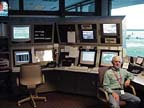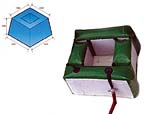
Emerging government standards and regulations to protect airports focus primarily on three areas. Most security executives know of the screening of passengers and baggage and the challenges in that effort.
But there are procedures and products to protect the airport perimeter, including barriers and bollards to protect from vehicle attacks as well as traffic controllers for vehicle access control. And there also are improvements in door access controls for airport and airline employees. The advances in these latter areas also impact security operations at corporate and commercial organizations.
For example, as part of a multi-million dollar enhancement at the Port Columbus International Airport in Ohio, Delta Scientific, Valencia, Calif., motorized traffic controllers are on the first two levels of the multi-level parking garage. These levels accommodate 1,200 rental vehicles, rental transaction counters and vehicle wash and fuel centers. The Delta MTC31 motorized traffic controller provides protection against unauthorized vehicle traffic into or out of protected areas. It incorporates what Delta calls Sabre Tooth Control Teeth that are rotated into position.

Other barriers have an even higher security look and feel.
One example: high security cable crash beams from Norshield Security Products, Montgomery, Ala. Such barriers come in units up to 19 feet wide.
Beyond hardening the perimeter, airport security executives continue to upgrade access controls within specific facilities.
Integrated Security
For instance, Gerald R. Ford International Airport, Grand Rapids, Mich., has contracted with Johnson Controls of Milwaukee, Wis., to provide an integrated security system and network upgrades recently. The $2.6 million contract includes installation and integration of a card access control system serving approximately 2,200 employees, and an advanced security video system with digital video recording. The new access system features smart card technology, but can be configured as needed to accommodate biometrics.“In addition to updating our aging security equipment, Johnson Controls is installing a system capable of incorporating additional security technologies down the road,” Robert Benstein, the airport’s public safety and operations director, says.
Integration is through a Cardkey P2000R security management system, which will enable airport personnel to monitor and control electronic security devices at any time from one main command center.

Sidebar: Inflating to Mitigate Bomb Blast
Airport security officers and first responders now seek technology and products which, when facing bomb threats, can be easily deployed and effective at minimizing the potential impact of a bomb blast.One unique, new solution is a self-inflating product that is filled with water to create a barrier that holds back bomb fragments.
From Washington, D.C.-based CINTEC America, the Blastec Bomb Bin is a blast mitigation tool.
It is made of internally reinforced fabric, and deployed manually or robotically using appropriate bomb disposal equipment. To deploy, the bin is first filled with air to provide stability and then water through a hose. The water displaces the air through a pressure relief valve. The unit is open at the top and bottom to facilitate deployment and access to the suspect object if required.
